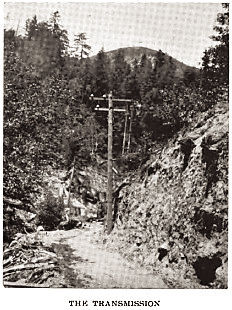In December 1895, when weather permitted, promoter Fred Swanton and electrician Ed Lilly escorted a team of experts — sawmill men, flume builders, hydraulic engineers, and a surveyor — to the intended site of the water-powered electric plant on Big Creek.
The party walked the party through the 360-acre property, checking out locations for a dam and reservoir, to be fed by a 10,000-foot flume line. Numbers were bandied about—over 2 million gallons of water would be available, falling a total of 919 feet to operate two Pelton water wheels coupled to generators. Swanton estimated the cost of the project as “in the neighborhood of $46,000.” The most significant figure involved voltage—the power would be transmitted from Big Creek over high-tension wires to Santa Cruz, where it would be stepped down from 10,000 volts for distribution to households and other users.
A top priority was the construction of a lumber mill on the heavily-forested property to manufacture material for flumes, dam, and power-house. To carry the wires to the city limits, roughly 750 redwood trees would have to be felled, peeled, and shaped into 30-foot poles. A mutually beneficial deal was arranged with Judge Logan and other well-connected Santa Cruzans who owned timber lands in the vicinity and, shortly after New Year’s Day, 1896, the cutting began.
Swanton and Lilly spent considerable time in San Francisco, shopping for “electrical machinery, piping, wheels and wire—the complete outfit,” but they were forced to work with limited funds, due to what the entrepreneur referred to as “some matters to be settled” with the Santa Cruz Electric Light company. His estranged partner, President McNeil, who controlled a little over half the shares of the original firm, had taken over its board of directors. Employing a time-honored Wall Street tactic, the capitalist used his new majority to levy an assessment on all stockholders. Unless Swanton and his associates paid nearly $10,000 into the corporate treasury, their stock would be liquidated at public auction.
Legal action ensued. Judge Logan issued a temporary injunction, blocking the proposed sale, and several months of argument began. McNeil’s lawyers demurred, denying any personal animosity or that “said assessment was an attempt to freeze out the plaintiffs.” Their motion to dissolve the injunction failed in early February.
Meanwhile, Swanton and his helpers performed a key piece of political theater, traveling along the Coast Road from Santa Cruz to Big Creek, setting up stakes to indicate where the power poles would be placed. Advised by company attorney W. T. Jeter, Swanton submitted a far-reaching franchise application to the county supervisors, seeking permission to construct and maintain power lines “in, along, upon, over and across the public roads, streets, avenues, lanes, ways, and places within Santa Cruz county” for a period of fifty years. On February 6, 1896, it was announced that the 16-mile pole line had been successfully laid out. Four days later, the supervisors voted unanimously in favor of the proposal. They did insist, however that if the equipment was not kept in “safe and proper conditions,” the privileges granted to Big Creek Power would be forfeited. (To be continued.)













